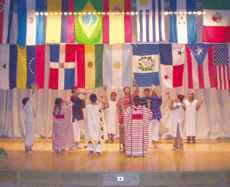LETS Listens at Arts On the Point Lecture
October 31, 2002
In another informal discussion in the Harbor Art Gallery, Wendy Baring-Gould, Director of Education and Outreach at Arts on the Point, continued with her mission in informing and explaining to the general public just what was going on with UMass Boston’s sculpture park. This is part of her constant goal of getting people, this time the attendees of the Life Enrichment Through Studies (LETS) program, to understand just how and why much of the artwork situated around the UMB campus came to be.
Baring-Gould started off the lecture with an explanation of the environment, how it was a “harsh, hard-edged physical space that was not a particularly hospitable or gentle place.” The icy winds and intimidating, prison-like ambience that surrounds the boxy brick buildings that make up UMB give proof to her point.
In describing the site, she also said that the wealth of space gave them a chance to mold it in such a way that the artwork not only blended with the scenery but, in some cases, provided a striking contrast with the humorous, ironic bent that much of it takes.
Take, for example Dennis Oppenheim’s Black. The artwork is made up of several human-sized, fiberglass, painted pots and kettles facing one another, outside of the Quinn Building Cafeteria. The dark, corroded look to them seems to add to the general bleak fall vista yet, if you consider the phrase “the pot calling the kettle black” and the slightly upraised lips of the crockery, as if in conversation, the joke behind the piece brings a smile to your face. Instead of seeing a “lonely tea party,” one laughs at the artistry that went into making a symbol of an old adage.
Another piece that often confounds is the giant, hulking steel structure created by Mark di Suvero, known as Huru. Weighing in at thirteen tons and towering over the Quinn Building shuttle stop at a startling sixty feet, the sculpture seems to be an inorganic, twisted tree stabbing into the harsh earth, yet the gentle swaying in the wind of the tuning fork-shaped top contradicts that view. What seems like a remnant of a condemned high rise actually symbolizes a greeting, as its name means “hello” and “goodbye” in an aboriginal language.
Di Suvero, who was paralyzed in an elevator accident, used a crane to shape each piece of steel and finished by welding the upper piece to its axis down below, somehow achieving a balance that allows it to swivel. The raw strength associated with unyielding metal seems negated when the birds perch along its arms, causing the piece to shift with their slight weight.
However, it is Tony Smith’s Stinger that Baring-Gould spent much of her time meditating upon. This sculpture is a thirty-two foot square, solid black, rectangular-shaped object whose only break in symmetry occurs with the gap that allows you to enter this void. At a height of six and a half feet, it is impossible for most to see over its walls, making it appear as if a pocket of unreality has firmly planted itself on the green grasses of Columbia Point. Paul Tucker, Director of Arts on the Point, has likened it to an “alien spacecraft.”
Indeed it does seem alien to have this black, hard-edged gouge in the idyllic shorefront of UMB. However, the piece of sculpture serves expressly to remind one of that; it is there to provide a contrast between the gentle slopes overlooking Dorchester Bay and the man’s ability to shape the environment around him.
Another work that was touched upon was Lagartos (“The Alligators”) by Luis Jimenez. As the son of a neon sign creator, Jimenez was fascinated by the use of fiberglass as a medium with the bright, explosive colors it put forth once it was coated with glaze. Much of his work is considered political, detailing the Chicano experience in America. Located on the plaza next to the Clark Athletic Center, the writhing reptiles have a metallic sheen as they appear to be playing around with one another.
As she finished speaking, a number of people in the audience had question upon question for Baring-Gould, as their curiosity had been roused. In spite of the rainy weather, she sated their questions with an improptu tour of the sculpture park, which many were happy to attend.





















































